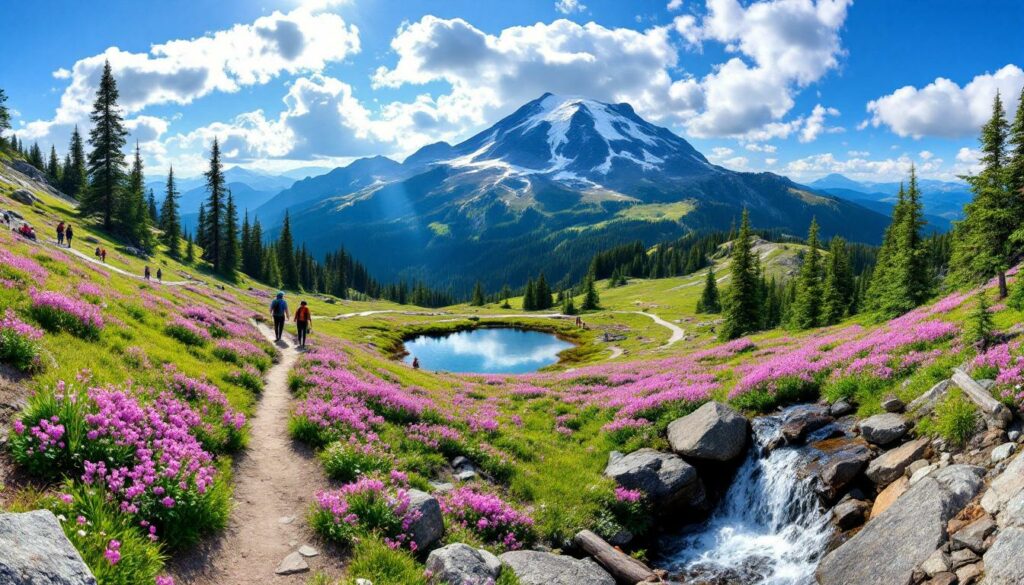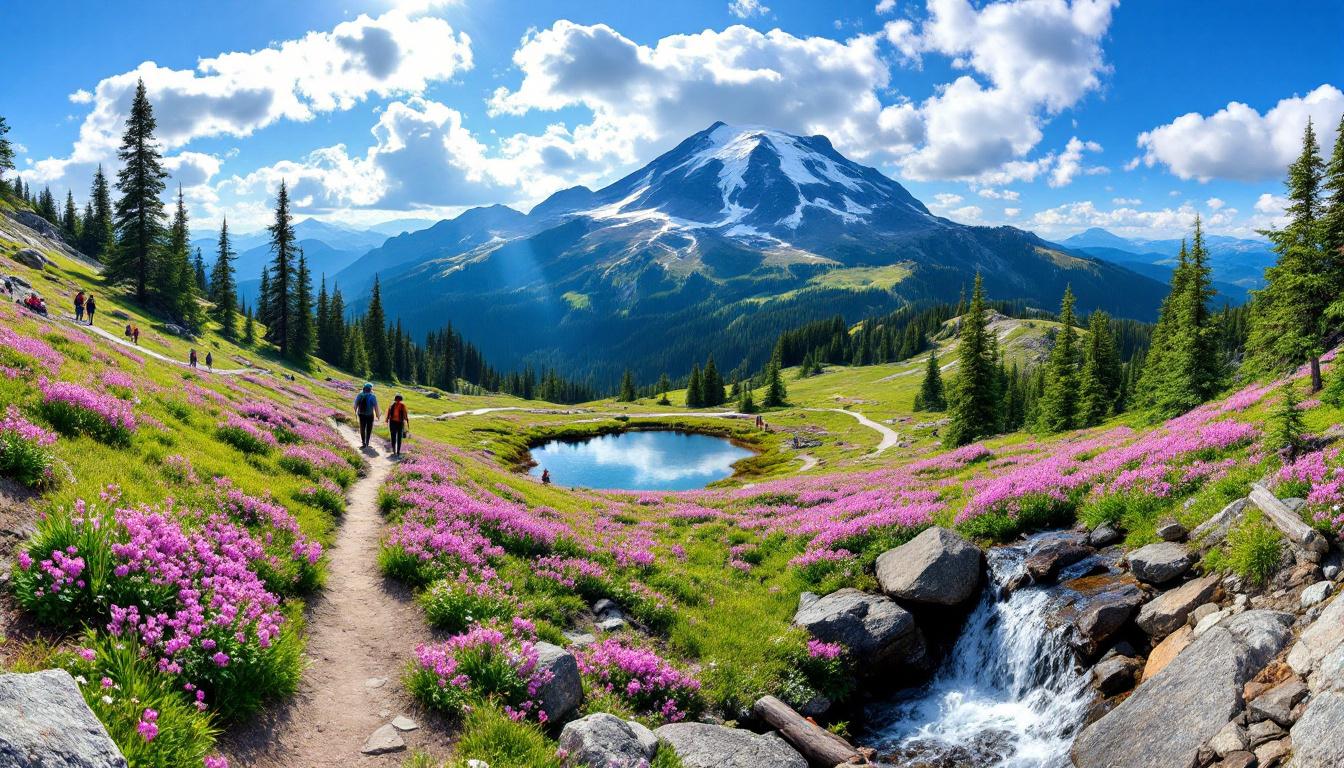What Makes Naches Loop Trail Special?
The Naches Loop Trail stands as a hidden gem in Washington's Cascade Mountains, offering one of the most accessible alpine experiences in the Pacific Northwest. This 3.2-mile loop combines the breathtaking scenery typically reserved for challenging backcountry hikes with the approachability needed for hikers of all abilities.
A Beginner-Friendly Alpine Experience
Situated at Chinook Pass, just east of Mount Rainier National Park, the Naches Loop Trail provides an ideal introduction to alpine hiking without the typical physical demands. With less than 700 feet of elevation gain spread gradually throughout the trail, hikers experience a relatively flat terrain that remains well-maintained throughout the hiking season.
What truly sets this trail apart is its immediate reward system – within minutes of leaving the trailhead, hikers are treated to spectacular views of Mount Rainier's eastern face. Unlike many alpine hikes that require hours of strenuous climbing before revealing their scenic treasures, Naches Loop delivers breathtaking panoramas almost immediately.
The trail caters perfectly to diverse hiking groups – families with young children can navigate the path without exhaustion, seniors appreciate the gentle grade, and first-time hikers gain confidence without overwhelming physical challenges. For those concerned about accessibility, the trail's well-defined path and moderate width accommodate hikers of varying abilities.
Perhaps most appealing to casual hikers is the lack of financial barriers – since the trailhead sits outside Mount Rainier National Park boundaries, no entrance fees or special permits are required. Simply park your vehicle at the Chinook Pass lot and begin your adventure.
Stunning Natural Surroundings
The trail's most captivating feature might be its vibrant alpine meadows, which transform seasonally into breathtaking wildflower displays. During peak season (typically mid-July through August), hikers traverse through carpets of magenta phlox, blue lupine, red paintbrush, and delicate white valerian. The meadows create a photographer's paradise with Mount Rainier's snow-capped peak serving as the perfect backdrop.
Approximately 15 minutes from the trailhead, a small alpine lake provides a perfect rest stop. The crystal-clear water reflects surrounding peaks on calm days, creating postcard-worthy photo opportunities. This lake serves as both a scenic highlight and convenient turnaround point for those seeking a shorter adventure.
The trail's elevation offers panoramic views extending far beyond Mount Rainier. On clear days, hikers can spot Mount Adams, Mount Stuart, and numerous other Cascade peaks dotting the horizon. These vistas provide natural orientation points throughout the hike.
Several small waterways cross the path, including babbling brooks and seasonal waterfalls that add auditory ambiance to the journey. These water features create natural rest stops where hikers can cool off during warmer summer days.
Perhaps most exciting for hiking enthusiasts is the trail's intersection with the historic Pacific Crest Trail (PCT). For a short stretch, Naches Loop hikers walk the same path traveled by thru-hikers journeying from Mexico to Canada. This connection provides a taste of the iconic 2,650-mile trail without the months-long commitment.
How Do You Access the Naches Loop Trail?
Reaching this alpine wonderland requires some planning, especially considering seasonal accessibility and potential crowds during peak periods. The journey itself offers scenic views that serve as a perfect prelude to the hiking experience.
Getting to Chinook Pass
From Seattle, follow I-90 east to Highway 410, then continue southeast through Enumclaw and the charming town of Greenwater. The drive takes approximately 2 hours, winding through increasingly mountainous terrain. Portland residents face a slightly longer journey (about 3 hours) via I-5 north to Highway 12, then connecting to Highway 410 northbound.
The trailhead parking area sits at Chinook Pass (elevation 5,430 feet), directly adjacent to the highway. While the lot accommodates approximately 30 vehicles, it fills quickly on summer weekends. Arriving before 9 am greatly increases your chances of securing a spot, especially during wildflower season (mid-July through August). An overflow parking area exists about a quarter-mile down the highway, though this adds distance to your hike.
Facilities at the trailhead remain basic but sufficient – vault toilets are available, though no running water exists. Pack all necessary water for your journey, planning for at least 1-2 liters per person depending on temperature and hiking pace.
The trail's seasonal accessibility presents a critical planning consideration. Typically snow-free from early July through mid-October, the exact opening dates vary annually based on snowpack and spring temperatures. In low-snow years, the trail may open by late June, while heavy snow years might delay access until mid-July. The Washington Trails Association website and Forest Service ranger stations provide up-to-date conditions.
Trail Navigation Essentials
Hikers face an important decision at the trailhead – clockwise or counterclockwise? Most experienced hikers recommend traveling counterclockwise, which positions Mount Rainier directly ahead during the most scenic stretches rather than behind you. This route also tackles the trail's steepest (though still moderate) section early, while energy reserves remain high.
Those with children or seeking gentler grade might prefer the clockwise direction, which distributes elevation gain more gradually. Either direction offers spectacular views, so the choice ultimately depends on personal preference.
Clear trail markers make navigation straightforward for most hikers. Look for wooden posts at major junctions, often displaying both Naches Loop and Pacific Crest Trail insignias. The most critical junction occurs where the Naches Loop intersects with the PCT – counterclockwise hikers should follow signs for "Naches Loop via PCT" at this point.
For tech-savvy hikers, several digital resources enhance navigation confidence. The trailhead sits at GPS coordinates 46.8789, -121.5178, and various hiking apps (AllTrails, Gaia GPS) offer downloadable maps functioning without cell service. Given the spotty cellular coverage in the area, downloading maps before arriving is highly recommended.
What Geological Wonders Will You See?
The Naches Loop Trail reveals an extraordinary three-act geological story spanning millions of years. Understanding these formations enhances appreciation for the dramatic landscape that surrounds hikers throughout the journey.
The Three-Act Geological Story
The first geological act began approximately 30 million years ago with the formation of the Ohanapecosh Formation – the "basement rocks" visible along sections of the trail. These distinctive green-hued rocks originated from submarine volcanic eruptions, when the Pacific Northwest landscape bore little resemblance to today's mountains.
Volcanic material erupted underwater, creating layers of tuff (compacted volcanic ash) and breccia (angular rock fragments cemented together). Over millions of years, these underwater deposits underwent metamorphic processes under intense heat and pressure, transforming into the distinctive greenish rocks visible today.
The Ohanapecosh Formation's layered appearance tells the story of repeated volcanic activity over millions of years. Careful observers will notice the band-like structure in exposed rock faces, with each layer representing separate eruption events. These ancient rocks provide the foundation upon which the rest of the region's geological story unfolds.
The Dramatic Rock Formations
The second geological act occurred approximately 20 million years ago with the intrusion of the Tatoosh Pluton – a massive underground magma chamber that never reached the surface as a volcano. Instead, this molten rock slowly cooled beneath the surface, crystallizing into the distinctive granite visible in many locations along the trail.
The resulting granite exhibits a characteristic "salt-and-pepper" appearance, with light-colored feldspar crystals contrasting against darker minerals like hornblende and biotite. This intrusive rock literally pushed its way through the older Ohanapecosh Formation, creating dramatic contact boundaries visible to hikers with observant eyes.
Several viewpoints along the eastern portion of the loop reveal these granite intrusions cutting through older green basement rocks. These boundaries represent windows into Earth's violent past, where molten rock at temperatures exceeding 1,800°F forced its way through existing formations.
Mount Rainier's Volcanic Legacy
The third and most recent geological act began less than 1 million years ago with the formation of Mount Rainier itself. This stratovolcano built upon the existing geological foundations, with successive eruptions adding layers of andesite lava and volcanic debris to create the towering peak visible today.
From the Naches Loop Trail, hikers observe Mount Rainier's eastern face, which reveals clues to this volcanic history. The mountain's layered appearance demonstrates how repeated eruptions built the cone over hundreds of thousands of years. Glaciers carved deep valleys into these volcanic deposits, creating the distinctive radiating pattern visible on clear days.
Evidence of this younger volcanic activity appears in scattered volcanic bombs and pumice along sections of the trail. These lighter, porous rocks originated from explosive eruptions, where superheated gases created bubble-filled stones that were ejected into the air before landing in the surrounding landscape.
The geological story continues today, as Mount Rainier remains classified as an active volcano. While currently dormant, the mountain experiences occasional earthquake swarms and thermal activity, reminding us that this geological saga remains ongoing. The Naches Loop provides a front-row seat to both ancient and contemporary geological processes that continuously shape the Cascade Range.
What Wildlife and Flora Can You Expect?
The Naches Loop Trail traverses several distinct ecosystems, creating a haven for diverse plant and animal communities. The high-elevation environment supports specialized species adapted to harsh winter conditions and short growing seasons.
Alpine Meadow Ecosystems
The trail's subalpine meadows represent one of the most biodiverse habitats in the Cascade Range. During the peak blooming period from mid-July through early August, hikers encounter a spectacular wildflower display that transforms the landscape into a painter's palette of colors.
Purple lupine (Lupinus latifolius) often dominates open meadows, their spired flower stalks creating a sea of violet against green backgrounds. These nitrogen-fixing plants play a crucial ecological role, enriching soil for other species. Magenta paintbrush (Castilleja parviflora) adds striking red accents throughout the meadows, despite technically being a parasitic plant that derives nutrients from neighboring grasses.
More observant hikers might spot delicate alpine specialists like mountain heather (Phyllodoce empetriformis), whose bell-shaped pink flowers thrive in areas that remain snow-covered for 8-9 months annually. In drier, rocky sections, the fragrant western pasqueflower (Anemone occidentalis) emerges early in the season, later developing distinctive feathery seedheads that earn them the nickname "mouse-on-a-stick."
Several plant species found along the trail exist nowhere else on Earth outside the Cascade Range. The Cascade aster (Eucephalus ledophyllus) displays lavender ray flowers surrounding yellow disk centers, adapted specifically to the region's volcanic sulfide deposits and short growing season.
The ecological importance of these alpine meadows extends far beyond their visual appeal. These habitats serve as critical pollinator sanctuaries, supporting native bee and butterfly populations that struggle in lower-elevation environments affected by habitat loss and pesticide use. The short but intense flowering season creates a concentrated food source that sustains these pollinator populations.
Wildlife Viewing Opportunities
The Naches Loop's varied terrain supports diverse wildlife, though animal encounters require patience and awareness. Early morning or evening hikers have the best chances of wildlife sightings, when temperatures cool and animals become more active.
Marmots represent the trail's most commonly spotted mammals. These large, burrow-dwelling rodents (weighing up to 11 pounds) frequently sun themselves on rocky outcroppings during midday. Listen for their distinctive high-pitched whistle – a warning call that alerts other marmots to potential danger. These social animals maintain complex family groups within their rocky territories.
Bird enthusiasts should watch for mountain-specific species including Clark's nutcracker, a gray and black corvid with remarkable spatial memory. These birds collect and cache thousands of whitebark pine seeds annually, remembering hundreds of burial locations throughout winter. Their seed-storing behavior actually promotes forest regeneration, as forgotten caches often germinate into new trees.
For lucky hikers, larger mammals occasionally make appearances. Black-tailed deer frequent meadow edges during early morning and evening hours. Mountain goats sometimes traverse distant ridgelines, appearing as white specks against rocky backgrounds. Though rarely seen, black bears inhabit the surrounding forests, primarily foraging for berries and plant material rather than seeking human interaction.
When observing wildlife, maintain respectful distances (minimum 25 yards for most animals, 100 yards for larger mammals) and never approach or feed wild creatures. Binoculars enhance viewing experiences without disturbing natural behaviors. Wildlife photography along the trail works best with longer telephoto lenses (200mm minimum) that allow frame-filling images from appropriate distances.
When Is the Best Time to Hike Naches Loop Trail?
Timing significantly impacts the Naches Loop experience, with seasonal and daily considerations affecting everything from trail conditions to photography opportunities.
Seasonal Hiking Windows
The primary hiking season runs from early July through mid-October, though exact dates vary annually based on snowpack and weather conditions. Each period within this window offers distinct advantages and considerations.
Summer (July-August) represents peak season for good reason. Wildflowers reach their spectacular zenith, transforming meadows into kaleidoscopic displays. Temperatures generally remain comfortable, typically ranging from 60-75°F during daylight hours. Extended daylight provides maximum flexibility for start times, with sunlight often extending past 9 pm in July. However, this period also brings the highest visitor numbers, particularly on weekends.
Early fall (September-early October) offers compelling advantages for those willing to risk variable weather. Crowds thin dramatically after Labor Day, sometimes providing near-solitude even on weekends. Fall colors emerge as huckleberry bushes and mountain ash transform into brilliant reds and oranges. Temperatures cool to 45-65°F – perfect for comfortable hiking with proper layers. Mosquito populations disappear entirely, eliminating the minor nuisance that sometimes accompanies summer visits.
Weather patterns require consideration regardless of season. The trail's 5,400-foot elevation creates conditions that can differ dramatically from lowland forecasts. Afternoon thunderstorms occur frequently during summer months, typically developing between 2-4 pm. Morning fog often dissipates by 10-11 am, revealing stunning clear vistas. Always check mountain-specific forecasts before departing, as conditions change rapidly.
Snowmelt creates another timing consideration. In heavy snow years, some sections may retain snow patches into mid-July, particularly on north-facing slopes. Early season hikers should be prepared for occasional snow crossings, though trail-finding rarely presents difficulties due to previous hikers' tracks and natural corridors between trees.
Time of Day Considerations
The trail experience varies dramatically throughout the day, with each time period offering unique advantages for different hiking priorities.
Morning (7-10 am) provides optimal conditions for wildlife viewing and photography. Animals tend to be most active during cooler morning hours, particularly deer and marmots. The low-angle morning light creates dramatic shadows and illuminates Mount Rainier's eastern face with warm golden tones. Morning typically offers the calmest wind conditions, creating perfect reflections on the small alpine lake. Early starts also secure trailhead parking and provide solitude before day-hiking crowds arrive.
Midday (10 am-2 pm) brings warmer temperatures ideal for those concerned about morning chill. By this time, any morning fog has typically cleared, revealing maximum visibility to distant peaks. Wildflowers fully open in response to sunlight, displaying their most vibrant colors. However, midday also brings harsher overhead lighting for photography and coincides with peak trail traffic.
Late afternoon (2-6 pm) offers changing light conditions that gradually soften, reducing harsh shadows and contrast. Wildlife often becomes more active again as temperatures cool. By 4 pm, many day hikers have departed, creating more peaceful trail conditions. However, afternoon also brings increased risk of thunderstorm development, particularly during July and August.
Hiking duration varies significantly based on pace and stop frequency. Most hikers complete the 3.2-mile loop in 2-3 hours, though photographers and nature enthusiasts often extend this to 3-4 hours with frequent stops. Families with young children should plan for 3-5 hours, allowing ample time for rest breaks and exploration. The trail's relatively flat profile means most hikers maintain consistent timing regardless of direction traveled.
What Should You Bring on Your Hike?
Proper preparation enhances safety and enjoyment on the Naches Loop Trail. Despite its accessibility, the alpine environment demands appropriate gear and supplies.
Essential Gear Checklist
Footwear selection significantly impacts hiking comfort on the Naches Loop. While the well-maintained trail doesn't require heavy mountaineering boots, proper hiking footwear with ankle support and traction prevents common injuries. Trail runners work well for experienced hikers during dry conditions, while waterproof hiking boots provide better protection during early season when snow patches or mud might be present.
The mountain environment demands strategic clothing layers to accommodate temperature fluctuations that can exceed 30 degrees in a single day. Start with a moisture-wicking base layer that moves perspiration away from skin. Add an insulating mid-layer (fleece or synthetic down) for warmth retention. Always pack a waterproof/windproof outer shell regardless of forecast, as mountain weather changes rapidly. Many experienced hikers pack lightweight gloves and beanies even in summer, as exposed ridgelines can experience strong, cool winds.
Water requirements exceed those of lowland hikes due to elevation and sun exposure. Carry at least 1-2 liters per person, with additional supplies during warmer conditions. Since no reliable water sources exist along the trail (seasonal streams may be contaminated with bacteria), all water must be carried from the trailhead.
Nutrition needs increase at higher
Ready to Spot the Next Big Mineral Discovery?
Stay ahead of the market with Discovery Alert's proprietary Discovery IQ model, delivering real-time notifications on significant ASX mineral discoveries and transforming complex data into actionable investment insights. Visit the Discovery Alert discoveries page to understand how major mineral discoveries have historically generated substantial returns for early investors.




